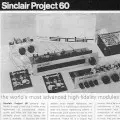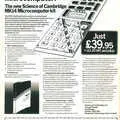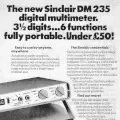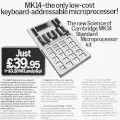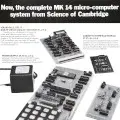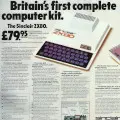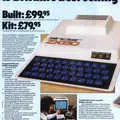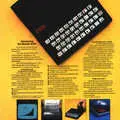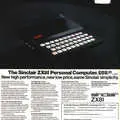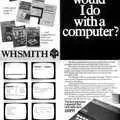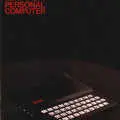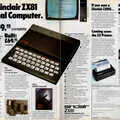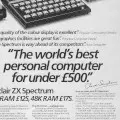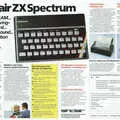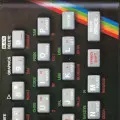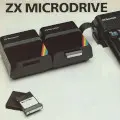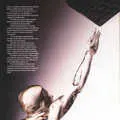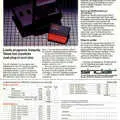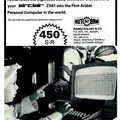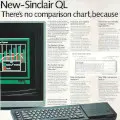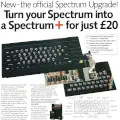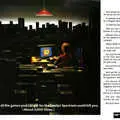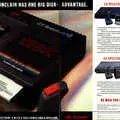
Sinclair Advert - November 1982
From Practical Computing
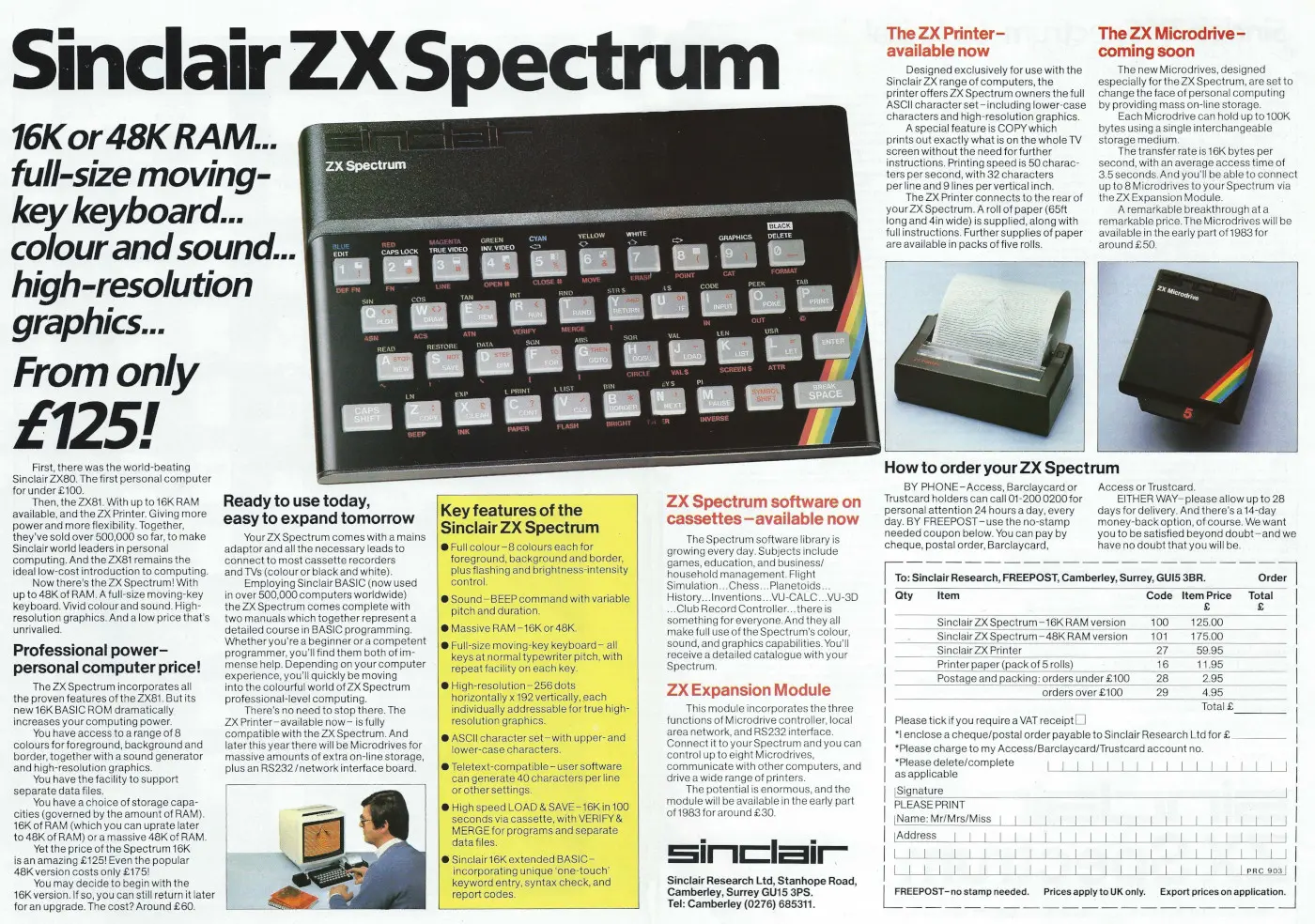
Sinclair ZX Spectrum: Colour and sound... High Resolution graphics... from only £125!
This advert shows the Mark 1 Spectrum - as shown by the light grey keys - which retailed for £125 (or around £550 in 2025 terms), and in a bit of a Sinclair theme, promised "coming soon" stuff in the form of the ZX Microdrive.
The Spectrum was launched at the Churchill Hotel on Friday, 23rd April 1982, however the Microdive didn't appear until July 1983 - over a year late[1].
By the time this advert appeared - some seven months after the launch of the Spectrum - Sinclair was having all sorts of problems with deliveries of its new micro, with some buyers waiting for several months for their machine.
It had been eight weeks since launch before the first Spectrums were actually delivered[2], and delays got worse from there until settling down towards the end of the year.
Microdrives became something of a Bête Noir for Sinclair. Ever since it had been announced, Sinclair was cagey about his £50 (£230), 100K rapid-access storage system, fending off speculation that it was not a real disc system. It wasn't - it used tape loops. Sinclair said:
"it will do exactly the same job as the other drives. The micro-floppy is the most important thing we're doing and contrary to what [co-founder of arch-rival Acorn] Hermann Hauser supposes it is actually well in advance of the 3" and 3.5" machines the Japanese are doing and [will be] less expensive[3]".
Hermann Hauser, on the other hand, had actually praised Sinclair for trying to develop new storage devices, saying "The Microdrive heralds a new generation of microfloppies, although ... I think he has got it wrong - it is unwise at the moment to go for a non-standard drive".
Hauser expected the Microdrive to become obsolete quickly because of its lack of real random access"[4]. Not only that, but the drives suffered from all sorts of reliability issues, especially later on when they were crammed in to the Sinclair QL[5]
The Spectrum itself was rooted in the design of the first of the ZX machines - the ZX80, launched in the February of 1980.
The specification of this machine - as Clive Sinclair admitted - was more to do with marketing than with application, with the sole aim of releasing a computer for less than £100 "whatever the effects of such a constraint on the ultimate usefulness of the product".
Even the ZX80's infamous single-keystroke BASIC entry was the result of a marketing decision, with Sinclair deciding that as not many customers would be actual typists, single-key entry would be a "valuable sales feature".
Apparently the inspiration for this came from an obscure single-keystroke programming dialect found on a Wang computer from Clive's days at Radionics in St. Ives, but it was also said that any advantages single-key entry offered were insufficient compensation for the horror of the keyboard.
The membrane keyboard the ZX80 used wasn't particularly responsive and so would have precluded any sort of real typing in any event, so perhaps Clive was right about non-typists. He admitted as much stating that he really considered old-style electronics hobbyists as his original target audience.
The ZX80 - although dismissed by reviewers as a "gizmo" - still managed to sell 25,000 units in the year that followed.
Its BASIC, which was loosely based on the ANSI Minimal dialect, was written by John Grant of Nine Tiles and is generally considered as a "masterpiece of efficient and economic coding".
It was highly customised to the ZX80 and its very limited memory, but was never considered as the software foundation for the entire ZX range.
However - and perhaps inevitably - that's exactly what happened when, despite opposition from Nine Tiles, Clive Sinclair insisted on the software remaining untouched on the ZX81, albeit with some extensions tacked on, including support for floating-point numbers and improved display handling.
That wasn't too much of a problem for the ZX81, which came along in, er, 1981, and which was significantly more successful, selling more than 500,000 by the end of 1982.
Unfortunately, by the time the same code was pressed into service on the ZX82 - aka Spectrum - the coding structures "finally collapsed beneath the demands of the Spectrum's massively expanded memory", according to John Grant. It was said that:
"[code which had been] clever and efficient [at] handling data for a 1K system proved totally inadequate when applied to the processing requirements of a 16K or 48K Spectrum"
Much of the work to implement the Spectrum's software was done by Steve Vickers at Nine Tiles, with Richard Altwasser in Sinclair's research department handling the hardware and also acting as a "buffer" between the two companies.
However, the two of them left during the process to start a new company - Jupiter Cantab - and launch a new micro, the Jupiter Ace.
This left the remaining development in a state of disarray, although whilst it was thought only the input/output routines remained to be finished, there were no peripheral prototypes to test against, and almost daily changes in requirements.
The hard deadline of the Spectrum's launch date meant that eventually the earliest machines would be launched with unfinished ROMs - ironically, Nine Tiles had previously recommended a rewrite of the software at a cost of £15,000, but Clive declined, with the result being "erratic, sluggish performance from the last of the ZX range".
In a wide-ranging article discussion Clive Sinclair and his ZX computers, the authors of the book "Soul of the Sinclair Machine" broke with the tradition of referring to Clive Sinclair as an "inventor", "innovator" or a "visionary", and reckoned that he was more of a "technological barrow-boy, a provider of technical toys he thinks the public should want".
They concluded that rather than advancing the art of computing:
"The avuncular Uncle Clive, posing as some sort of Ronald MacDonald of information technology, with his cheap keyboards, minimal components, impotent speakers and quirky BASICs has in fact served the cause of consumer electronics alone, which is the art of providing technological gimickry at a low enough cost so you can grab the innovative toy and gadgeteer market[6]".
Date created: 14 December 2023
Last updated: 11 December 2024
Hint: use left and right cursor keys to navigate between adverts.
Sources
Text and otherwise-uncredited photos © nosher.net 2025. Dollar/GBP conversions, where used, assume $1.50 to £1. "Now" prices are calculated dynamically using average RPI per year.
